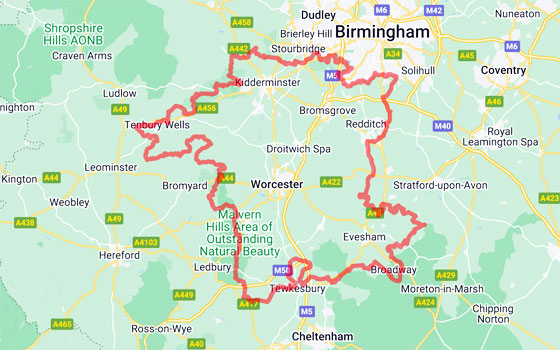Introducing Worcestershire
Introducing Worcestershire
Brett Westwood and Harry Green
Worcestershire is a comparatively small county, only around 670 miles square, but for its size, it includes a remarkable range of habitats and wildlife. Geology and location are key to this rich variety. In the north-west, the thin-soiled Silurian rocks and Coal Measures are cloaked by the ancient oakwoods of the Wyre Forest.
Across the Severn, the sandy heaths around Kidderminster and Bewdley support plants and invertebrates more typical of East Anglian breckland. The south-west of the county is dominated by the igneous whalebacks of the Malvern hills looming over commons grazed for centuries.
In the south-east, the oolitic limestone of Bredon Hill is a northern outlier of the Cotswolds. In between lies farmland which although significantly modified by agricultural practices, still includes many ancient hedgerows and flower-rich meadows, for example in the Severn and Avon valleys.

These two distinctive rivers run through extensive flood-plains. In the west, a third, the Teme courses through a steep-sided valley below ferny dingles which harbour remnants of ancient woodland, to join the Severn at Worcester. The Avon irrigates the orchards and market-gardening country of the Vale of Evesham while to its north is the ancient Forest of Feckenham, still represented by butterfly-rich, semi-natural woods. The county’s urban environments include miles of canals, connecting the Birmingham and the Black Country to the north with Worcester itself, home to breeding peregrine falcons which oversee the county cricket ground from their eyrie on the cathedral.
Worcestershire’s location and its relatively mild climate mean that species from all points of the compass meet here. Few other counties in the UK can boast both breeding Nightingale and Dipper, while the trio of oakwood migrants, Pied Flycatcher, Redstart and Wood Warbler, all representative of northern and western Britain, breed in the Wyre Forest. The acid heaths and grasslands around Kidderminster support nationally important populations of bees and wasps as well as many other insects and spiders more typical of eastern and coastal sites. On Bredon Hill, Man Orchid reaches its north-westerly limit in the UK and Bechstein’s Bat has its most northerly breeding UK colony in the woods east of Worcester. Some animals such as the enigmatic Land Caddis, have their national stronghold in the county.
